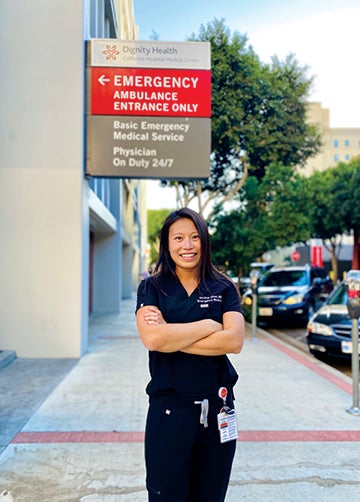Bridges to Hope
Rice alumna Jennifer Zhan is creating a path to substance use disorder treatment.
Winter 2024 | Interview by Mabel Tang '23

Since 2019, Jennifer Zhan ’10 has been working with CA Bridge, a Public Health Institute program, to create new approaches to substance use treatment within hospital emergency department settings. Zhan’s work began at the California Hospital Medical Center in downtown Los Angeles, where she works. “Before starting our program, my hospital had no medications or protocols to effectively treat patients with substance use disorder,” Zhan says. “We would temporarily alleviate their symptoms and discharge them immediately. These patients would leave and come back with withdrawal symptoms or other complications of ongoing drug use.”
A grant from the CA Bridge program allowed Zhan to hire a patient navigator and begin building the substance use treatment program at her hospital. Since then, she has been working to help implement the program across dozens of state hospitals. Zhan spoke with us about the importance of emergency departments in addressing addiction.
Tell us more about CA Bridge.
Every year, over 100,000 people die from a drug overdose. It has become a public health crisis in our country. A lot of patients with drug addiction do not have access to care in their communities or do not have the ability to pay. The emergency department is the only universal safety net in our health care system, so our program aims to bridge emergency care and ongoing treatment in the community to create an integrated system that improves health and equity.
The program provides hospitals with funding, clinical tools and training to help providers better serve patients with drug addiction. The CA Bridge model focuses on low-barrier medication for addiction treatment, linkage to care in the community, and creating a culture of harm reduction. CA Bridge started with eight participating hospitals; now, we have 278 hospitals onboard — about 85% of emergency departments in the state.
What’s different about this approach?
The reality is that substance use disorder is a chronic treatable disease, just like heart disease or diabetes or other medical conditions we see daily. We use medication for addiction treatment. Evidence shows that starting patients with opioid use disorder on medications like buprenorphine can lead to higher rates of retention in treatment and decreased risk of return to use or overdose. There are also medications that help with alcohol use disorder and stimulant use. With treatment, physical symptoms of drug withdrawal and cravings can be managed so that patients have a higher chance of stopping drug use and a lower risk of overdose or death.
How do you work with patient navigators and other stakeholders?
CA Bridge has collaborated with health systems, public health departments and policy advocates to expand our program. We rely on navigators to build connections, examine patients’ individual needs and help with social issues that are often at the root of drug addiction. Our program has partnerships to address complex social issues such as transportation, lack of housing, domestic violence and human trafficking.
How do you build trust between your patients and large health care institutions?
Language matters. We’ve all heard providers talk about “addicts,” “junkies” or “frequent fliers.” Instead, we advocate for terms like “person who uses drugs” or “person in recovery” to show that a patient has a problem rather than is the problem. Historically, this is a group of patients who experience discrimination and stigma along with a myriad of health and social inequities. We started with patient signage in the waiting room and triage area, with person-first language to tell patients we have a [medication-assisted treatment] program or to ask us about buprenorphine. Providers also wear pins in English and Spanish to let patients know that we can help treat drug addiction.
We need to foster an environment of safety, trust and understanding that using drugs is not a moral failing. It is our duty as emergency providers to treat it and prevent deaths from drug overdose. Culture change is important because we can throw clinical protocols and navigators in hospitals, but if there isn’t a belief that treating substance use disorders is our lane, it won’t happen.
How do you hope this field changes in the future?
I hope that our work inspires other states and health systems to promote treatment of substance use disorders and see these patients as humans with a chronic treatable disease. Our goal is to decrease overdose deaths nationwide with the hope that one day, there will be zero deaths from substance use. We would all celebrate on that day.
